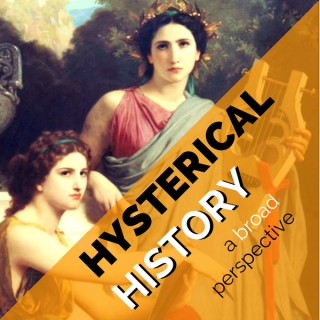Podcasts about madame lavoisier
- 6PODCASTS
- 6EPISODES
- 33mAVG DURATION
- ?INFREQUENT EPISODES
- Mar 8, 2021LATEST
POPULARITY
Latest podcast episodes about madame lavoisier
Alejandra Ruiz León - Las mujeres de ciencia están donde no miramos
Una historia que va desde Madame Lavoisier hasta nuestras enfermeras
Patricia Fara on Newton, Scientific Progress, and the Benefits of Unhistoric Acts
Patricia Fara is a historian of science at Cambridge University and well-known for her writings on women in science. Her forthcoming book, Life After Gravity: Isaac Newton's London Career, details the life of the titan of the so-called Scientific Revolution after his famous (though perhaps mythological) discovery under the apple tree. Her work emphasizes science as a long, continuous process composed of incremental contributions–in which women throughout history have taken a crucial part–rather than the sole province of a few monolithic innovators. Patricia joined Tyler to discuss why Newton left Cambridge to run The Royal Mint, why he was so productive during the Great Plague, why the “Scientific Revolution” should instead be understand as a gradual process, what the Antikythera device tells us about science in the ancient world, the influence of Erasmus Darwin on his grandson, why more people should know Dorothy Hodgkin, how George Eliot inspired her to commit unhistoric acts, why she opposes any kind of sex-segregated schooling, her early experience in a startup, what modern students of science can learn from studying Renaissance art, the reasons she considers Madame Lavoisier to be the greatest female science illustrator, the unusual work habit brought to her attention by house guests, the book of caricatures she’d like to write next, and more. Follow us on Twitter and IG: @cowenconvos Email: cowenconvos@mercatus.gmu.edu Follow Tyler on Twitter Facebook Newsletter
Philip Ball tells the story of Madame Lavoisier; translator of oxygen. At a time when science was almost a closed book to women, Madame Marie Anne Lavoisier’s skills were indispensable. A translator, illustrator and critic of scientific papers, she learnt chemistry herself and helped her husband Antoine Lavoisier develop his theory of the role played by oxygen in combustion. As modern science was taking shape it lacked any universal language, so communication in many tongues was vital to stay ahead of the game. Even today there is debate as to who can really be considered the discoverer of oxygen, but Madame Lavoisier’s gift for translation helped her husband compete against English rivals and banish their theories. Come the French Revolution however, Anton was branded a traitor to the state and sentenced to death. By a cruel twist of fate Marie lost both husband and father to the guillotine on the same day. Philip Ball talks to Patricia Fara at the University of Cambridge, about the largely unrecognised contribution that women like Marie Anne Lavoisier made to the early days of modern science, and to Michael Gordin of Princeton University about the importance of scientific translation in the past and how it features today, Picture: French chemist Antoine Laurent Lavoisier, Credit: Getty Images
Have you made any scientific discoveries? Were they funded by collecting taxes from the starving Third Estate? And did your wife make sure you'd be remembered? No, that was all for Antoine! Join us this week, as Hailey teaches Alexis about Madame Lavoisier...and her husband is there too, I guess. Special thanks to Swing Whale for our music! See acast.com/privacy for privacy and opt-out information.
Love, Hate, and Sex from the History of Science
This Valentine’s Day we could have just brought you some sappy love stories from science’s past. But instead we offer you three tales of lust, loneliness, betrayal, pettiness, and not one, but two beheadings. Credits Hosts: Alexis Pedrick and Elisabeth Berry Drago Senior Producer: Mariel Carr Producer: Rigoberto Hernandez Reporters: Alexis Pedrick and Elisabeth Berry Drago Audio Engineer: James Morrison Photo illustration by Jay Muhlin Additional audio production by Dan Drago Music Music courtesy of the Audio Network Research Notes Martha Drinnan “Is Laurel Hill Haunted?” Laurel Hill Cemetery Blog, Laurel Hill Cemetery, Philadelphia, April 30, 2018. https://laurelhillcemetery.blog/2018/04/30/is-laurel-hill-haunted/. Sherman, Conger. Guide to Laurel Hill Cemetery, Near Philadelphia, 1847. Philadelphia: C. Sherman, 1847. https://archive.org/details/guidetolaurelhi00shergoog. Strauss, Robert. “Grave Sights.” Philadelphia Inquirer, October 29, 2010. https://www.philly.com/philly/entertainment/20101029_Grave_sights.html. It's a Thin Line Between Love and Hate Duveen, Denis. “Madame Lavoisier 1758–1836. Chymia 5 (1953): 13–29. https://www.jstor.org/stable/pdf/27757161.pdf?seq=1#page_scan_tab_contents. Everts, Sarah. “Acknowledging Madame Lavoisier.” Artful Science (blog), C&EN, June 1, 2011. http://cenblog.org/artful-science/2011/06/01/acknowledging-madame-lavoisier/. Hoffmann, Roald. “Mme. Lavoisier.” Scientific American 90 (2002): 22–24. http://www.roaldhoffmann.com/sites/all/files/mme_lavoisier.pdf. “The Human Side of Science: Edison and Tesla, Watson and Crick, and Other Personal Stories behind Science’s Big Ideas (2016).” Schoolbag.info. https://schoolbag.info/science/human/6.html. “Marie-Anne Paulze Lavoisier.” Wikipedia, accessed February 11, 2019. https://en.wikipedia.org/w/index.php?title=Marie-Anne_Paulze_Lavoisier&oldid=874565953. Touched by the Angels Clucas, Stephen, ed. John Dee: Interdisciplinary Studies in English Renaissance Thought. Dordrecht: Springer, 2006. Dee, John. The Compendious Rehearsal. London: Thomas Hearne, 1726. British Library (website), Collection Items. https://www.bl.uk/collection-items/john-dee-is-accused-of-sorcery-after-staging-a-greek-play. Harkness, Deborah. John Dee’s Conversations with Angels: Cabala, Alchemy, and the End of Nature. Cambridge: Cambridge University Press, 2006. In, Mystical Metal of Gold: Essays on Alchemy and Renaissance Culture, edited by Stanton J. Linden, 35–79. New York: AMS, 2007. Sherman, William Howard. John Dee: The Politics of Reading and Writing in the English Renaissance. Amherst: University of Massachusetts Press, 1997.
Stories From The Stacks: Dr. Aya Tanaka on the Language of Debt in Historical Correspondence
Dr. Tanaka discusses her research on the correspondence between Pierre-Samuel du Pont de Nemours and Madame Lavoisier and the language of debt (intellectual and financial) in their letters. Dr. Tanaka is an adjunct professor at New York University's Stern School of Business. Stories from the Stacks is an ongoing program from the Center for the History of Business, Technology, and Society featuring interviews with researchers who share the excitement of discovering the rich and varied historical materials in the Hagley Library’s collections. Listen to additional episodes at www.hagley.org/storiesfromthestacks.









